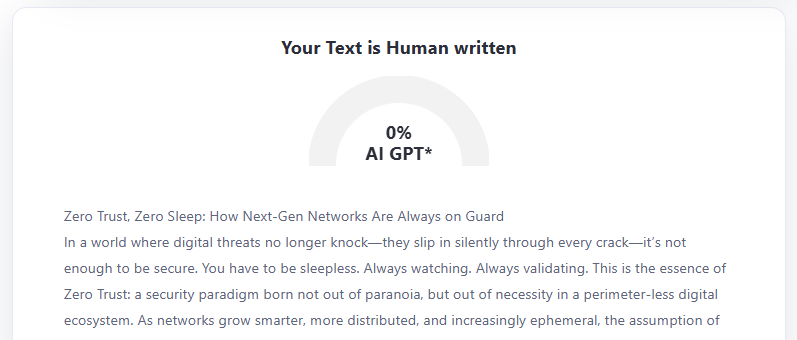In a world where digital threats no longer knock—they slip in silently through every crack—it’s not enough to be secure. You have to be sleepless. Always watching. Always validating. This is the essence of Zero Trust: a security paradigm born not out of paranoia, but out of necessity in a perimeter-less digital ecosystem. As networks grow smarter, more distributed, and increasingly ephemeral, the assumption of “trusted” internal access is no longer just dangerous—it’s obsolete.
The Legacy of Trust: Why Networks Grew Vulnerable
Network security for many years depended on the concept of castles and moats. Have a solid outside line of defense – firewalls, VPNs, intrusion prevention systems, etc. – and suppose trustworthiness of each insider within the walls. This strategy was effective in the era where there were slow changing networks with users operating from corporate workstations at the office. However, today, remote work, BYOD (Bring Your Own Device), SaaS sprawl, and API-driven everything have turned that model into Swiss cheese.
The biggest vulnerability in traditional models wasn’t malware or misconfigurations—it was trust itself. Once a user or device crossed the perimeter, their internal traffic was often granted excessive access. This lateral freedom created a perfect storm: attackers only had to breach once to move freely and deeply. The more interconnected the systems, the more devastating the consequences.
Botnets in the Boardroom: What “Inside” Means Now
The notion of “inside” the network no longer has much meaning for attackers. Contractors working out of coffee shops, third-party vendors with API access, and unpatched IoT devices sitting on the corporate LAN all can be used as attack vectors—and have been. Even the humble coffee machine can be an attack vector.
Modern botnet attacks quietly exploit these “trusted” zones. Once a single compromised device is inside the network, the botnet can spread, learn, and amplify. What’s more alarming is how these attacks often evade traditional detection systems — until the damage becomes visible. For those unfamiliar with how botnets operate or evolve, this breakdown on Moonlock https://moonlock.com/botnet-attacks offers a clear, accessible overview of their mechanics and impact.
Zero Trust seeks to eliminate the entire concept of a “low-risk zone” by treating every request, user, and packet as suspicious until proven otherwise.
Principles of Zero Trust: More Than a Buzzword
Zero Trust is often thrown around as a silver bullet, but in practice, it’s a philosophy implemented through multiple disciplines:
- Least Privilege Access: Every user or service is granted only the minimal permissions required to perform their tasks. No more broad internal access.
- Microsegmentation: Networks are divided into granular zones so that even if one segment is compromised, lateral movement is severely limited.
- Continuous Authentication: It’s not enough to validate identity once at login. Systems must continually evaluate behavior, device posture, geolocation, and context.
- Visibility & Analytics: With Zero Trust, logs become intelligence. Monitoring not only who accessed what — but also why, how, and under what conditions — becomes the cornerstone of defense.
Importantly, Zero Trust isn’t a product or a feature—it’s a mindset shift. Organizations often stumble when they try to “buy” Zero Trust instead of embedding it into their architecture and culture.
24/7 Security: The Shift Toward Non-Human Defenders
One of the lesser-discussed elements of Zero Trust architecture is the shift in when security operates. In the traditional model, most detection systems were reactive and human-driven: alerts, reviews, incident response. Today’s Zero Trust-aligned systems run autonomously and constantly—security has become a sleepless function.
Behavioral analytics engines, automated policy enforcement, and AI-based anomaly detection systems are the new night shift. They don’t sleep, they don’t overlook alerts due to fatigue, and they scale with cloud-native infrastructure. The ability to detect, isolate, and contain a threat without waiting for a human to respond is one of the reasons Zero Trust is not just about prevention, it’s about endurance.
Designing for Intent, Not Just Access
One of the more cutting-edge developments in Zero Trust implementation is intent-aware access control. It’s not just “can this user access this resource?” but “why is this access being requested now, from here, and for what purpose?” This model factors in contextual variables—time of day, department activity, workload behavior—to determine if an action is not only permitted, but expected.
This approach moves security from being a static compliance function to a dynamic decision-making authority. Rather than just looking for malicious activity based on known rules and threat intelligence, this type of security system is also on the lookout for suspicious activity that doesn’t seem to make sense, even if it doesn’t technically break any rules.
No Finish Line, Just Vigilance
Implementing Zero Trust isn’t a project—it’s a journey with no finish line. As environments evolve, so do threats. The promise of Zero Trust isn’t perfect security—it’s continuous skepticism wrapped in automation, visibility, and control.
Botnets will still form, exploits will still surface, and credentials will still leak. But in a Zero Trust world, those intrusions meet not a wall—but a maze of locked doors, identity checks, and constant surveillance. No network sleeps anymore. It simply waits, watching, always verifying—never trusting.



2.7%

